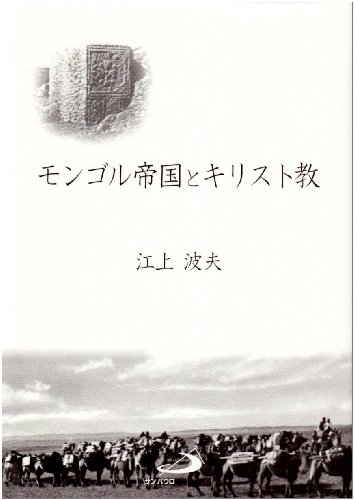8 0 0 0 オロン・スム遺跡調査日記
8 0 0 0 モンゴル帝国とキリスト教
4 0 0 0 OA アイヌのチャシとロシアのゴロディシチェ : 特集 日本民族=文化の起源と系統
- 著者
- 江上 波夫
- 出版者
- 日本文化人類学会
- 雑誌
- 民族學研究 (ISSN:24240508)
- 巻号頁・発行日
- vol.13, no.3, pp.278-284, 1949 (Released:2018-03-27)
Many prehistoric forts (the so-called gorodishches) have been found in Russia, particularly in the Volga-Kama area and in Western Siberia, which some date as far back as 800 B. C., most are from the turn of the Christian era, that is, Bronze and Iron Age. They are believed to have been built by ancient Finno-Ugric peoples. These forts resemble the Aino chash or chashkot very closely, both in ground plan and construction of the forts, and in the abundant bone implements which they contain. The author is therefore inclined to conclude that ancient Finno-Ugric culture elements may have been transmitted to the Aino, or conserved by them with other Continental culture elements from the West.
3 0 0 0 OA 蒙古婦人の冠帽「顧姑」に就きて
- 著者
- 江上 波夫
- 出版者
- 日本人類学会
- 雑誌
- 人類學雜誌 (ISSN:00035505)
- 巻号頁・発行日
- vol.53, no.6, pp.259-277, 1938-06-25 (Released:2008-02-26)
- 参考文献数
- 23
2 0 0 0 OA クルナ水没文化財引き揚げ調査団報告第一次 (1971~1972年)
- 著者
- 江上 波夫
- 出版者
- 一般社団法人 日本オリエント学会
- 雑誌
- オリエント (ISSN:00305219)
- 巻号頁・発行日
- vol.15, no.1, pp.1-46_8,157, 1972 (Released:2010-03-12)
In 1855, more than 200 cases of the Assyrian antiquities which had been excavated by V. Place at the site of Khorsabad, containing the antiquities of Kuyunjik, Nimrud and Babylon, were sunken in the Tigris and the Chatt-el-Arab near Qurnah, where the Tigris conflicts with the Euphrates in Iraq, on the way to France. The Japan Mission for the Survey of the Under-Water Antiquities at Qurnah, under the auspices of the Society for Near Eastern Studies in Japan, the Directorate General of Antiquities of Iraqi Government and the Chunichi Newspapers, commenced the excavation of the first season on the first October, 1971 and continued it until 31 January, 1972.In the first phase, we established, first of all, what seemed to be most fruitful area according to the thourough study of documentations in hand. The salvage group concentrated their work for the antiquities in the Tigris from joint-point with the Euphrates to the distance of 7Km upstream. We conducted our researches to the river-bed-layers, having attempted to cover the entire area from the surface of the water, by the use of what is known as “sonostrater”. Then according to the result of the record of the instrument, we excavated more than 20 points of the river-bed by a dredger and made sounding by divers with boring-sticks. However, unfortunately, we could not locate any antiquities for which we had been searching. Nevertheless we gained considerable amount of natural and artificial materials for studing the geology of the river-bed-layers and the archaeological analysis of their contents. These materials seem to be very important, since the result of studies might become one of the most useful detector for locating and salvaging the expected relics in the coming season.In the second phase, the scholarly group made reseaches especially from the geographical, archaeological and historical points of view. In rather wide an area along the Tigris from Qurnah up to Azer, we made observations along the river-banks and collected stones, bricks and potteries found nearby. We visited the old men in the villages and gathered what seemed to be most important and valuable informations seemingly related to our project. On the other hand, we have tried to collect the air photographs, old maps and reports of explorations in the 19th century especially of the area of the lower Tigris. we attempted the best we could in order to obtain the related documentations until the end of our first season. However, contrary to our expectation, we could not procure them all in the shortage of time. Nevertheless, the results seem to be not small. Some maps and their scrutinizing study would undoubtedly give very important suggestions for the future researches of the sunken antiquities. So, we think, on the whole, our work of the first season might be regarded as successful, though we could not recover any antiquities.
1 0 0 0 OA 匈奴の祭祀
- 著者
- 江上 波夫
- 出版者
- 一般社団法人 日本人類学会
- 雑誌
- 人類學雜誌 (ISSN:00035505)
- 巻号頁・発行日
- vol.56, no.4, pp.187-217, 1941-04-25 (Released:2008-02-26)
1 0 0 0 スウェーデン出土の小仏像
- 著者
- 江上 波夫
- 出版者
- 東京国立博物館
- 雑誌
- 東京国立博物館研究誌 (ISSN:00274003)
- 巻号頁・発行日
- no.149, 1963-08
- 著者
- 江上 波夫
- 出版者
- 日本文化人類学会
- 雑誌
- 民族學研究 (ISSN:00215023)
- 巻号頁・発行日
- vol.13, no.3, pp.278-284, 1949
Many prehistoric forts (the so-called gorodishches) have been found in Russia, particularly in the Volga-Kama area and in Western Siberia, which some date as far back as 800 B. C., most are from the turn of the Christian era, that is, Bronze and Iron Age. They are believed to have been built by ancient Finno-Ugric peoples. These forts resemble the Aino chash or chashkot very closely, both in ground plan and construction of the forts, and in the abundant bone implements which they contain. The author is therefore inclined to conclude that ancient Finno-Ugric culture elements may have been transmitted to the Aino, or conserved by them with other Continental culture elements from the West.



